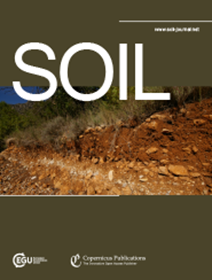Soil physico-chemical indicators for ecosystem services: a focus on water regulation
IF 4.3
2区 农林科学
Q1 SOIL SCIENCE
引用次数: 0
Abstract
Abstract. This study investigates the intricate relationship between soil properties and water-related processes, with a focus on their collective impact on ecosystem service provision, particularly water regulation. Conducted in three diverse regions Marchfeld (Austria), Bologna (North Italy) and Rmel (Tunisia), the research aims to identify key soil properties that influence water infiltration (INF), groundwater recharge (GWR), and crop water stress indexes (CWSI). Key soil characteristics such as saturated hydraulic conductivity (KS ), available water content (AWC), bulk density (BD), saturated water content (θs ), organic matter (OM), clay content and soil depth were analyzed for their role in regulating water movement and the overall hydrological balance. Pairwise correlation and multiple linear regression analyses were used to assess the interactions among soil water balance processes and soil properties. The results reveal significant variations between regions in terms of the factors that control infiltration, groundwater recharge, and CWSI. For example, in Marchfeld infiltration showed a strong positive correlation with BD (r = 0.74, p < 0.001), while CWSI had the most significant negative correlation with soil depth (r = -0.35, p < 0.001). Futhermore, multiple linear regression models were developed to assess the relevance of the different soil properties and of their interactions on the components of the soil water balance. As an example, in Marchfeld, the model for infiltration (r = 0.79, p < 0.001) was highly predictive, incorporating Clay, OM and soil depth. These results emphasize the critical role of key soil properties KS , AWC, BD, OM, clay content, θs and soil depth in controlling soil water processes. The study highlights the value of using these properties in predictive models to inform water management practices to optimize crop performance and soil conservation in different agricultural settings.生态系统服务的土壤理化指标:以水调节为重点
摘要。本研究探讨了土壤性质与水相关过程之间的复杂关系,重点研究了它们对生态系统服务提供,特别是水调节的集体影响。该研究在奥地利的Marchfeld、意大利北部的Bologna和突尼斯的Rmel三个不同的地区进行,旨在确定影响水入渗(INF)、地下水补给(GWR)和作物水分胁迫指数(CWSI)的关键土壤特性。分析了饱和导水率(KS)、有效含水量(AWC)、容重(BD)、饱和含水量(θs)、有机质(OM)、粘土含量和土壤深度等关键土壤特征对水分运动和整体水文平衡的调节作用。采用两两相关分析和多元线性回归分析评价了土壤水分平衡过程与土壤性质之间的相互作用。结果表明,控制入渗、地下水补给和CWSI的因素在区域间存在显著差异。例如,Marchfeld浸润与BD呈强正相关(r = 0.74, p <;0.001),而CWSI与土壤深度负相关最为显著(r = -0.35, p <;0.001)。此外,还建立了多元线性回归模型,以评估不同土壤性质及其相互作用与土壤水分平衡成分的相关性。例如,在Marchfeld中,入渗模型(r = 0.79, p <;0.001)具有高度预测性,包括粘土、OM和土壤深度。这些结果强调了关键土壤性质KS、AWC、BD、OM、粘粒含量、θs和土壤深度在控制土壤水分过程中的关键作用。该研究强调了在预测模型中利用这些特性为水管理实践提供信息的价值,从而优化不同农业环境下的作物性能和土壤保持。
本文章由计算机程序翻译,如有差异,请以英文原文为准。
求助全文
约1分钟内获得全文
求助全文
来源期刊

Soil
Agricultural and Biological Sciences-Soil Science
CiteScore
10.80
自引率
2.90%
发文量
44
审稿时长
30 weeks
期刊介绍:
SOIL is an international scientific journal dedicated to the publication and discussion of high-quality research in the field of soil system sciences.
SOIL is at the interface between the atmosphere, lithosphere, hydrosphere, and biosphere. SOIL publishes scientific research that contributes to understanding the soil system and its interaction with humans and the entire Earth system. The scope of the journal includes all topics that fall within the study of soil science as a discipline, with an emphasis on studies that integrate soil science with other sciences (hydrology, agronomy, socio-economics, health sciences, atmospheric sciences, etc.).
 求助内容:
求助内容: 应助结果提醒方式:
应助结果提醒方式:


